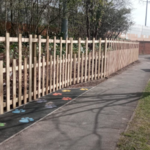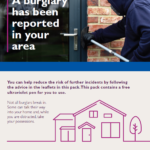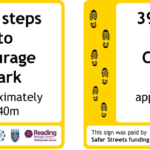Safer Streets 2: 2021-22
In June 2021, the Home Office announced that Reading had been successful in its bid for approximately £402,000, which was submitted by Thames Valley’s Police and Crime Commissioner’s Office, to tackle neighbourhood crime issues, such as robbery, burglary and vehicle crime, specifically in parts of Coley and Oxford Road. The funding allocated by the Home Officer had to be spent by 31 March 2022.
Officers from Reading Borough Council, Thames Valley Police, the Office of the Police and Crime Commissioner (Thames Valley) and local residents have been working on a number of initiatives, including installing CCTV, improving street lighting, enhancing burglary prevention packs, offering community crime training and creating a Forest School. You can find out more information below or by contacting the Community Safety Partnership team at csp@reading.gov.uk.
Safer Streets initiatives in Coley
- We improved local signage to encourage people to use Courage Park and deter criminal behaviour.
- We cut back overgrown trees and installed gating to deter motorbikes and anti-social behaviour along Lambs/Sheeps Lane.
- We worked with Nature Nurture to create a Forest School at Holy Brook Nook for the local primary schools, community groups and residents.
- We will install mobile CCTV cameras at key crime hotspots to monitor and manage issues.
- We have improved burglary prevention packs to support victims of crime and potential victims – including neighbours and vulnerable residents.
Safer Streets initiatives in Oxford Road
- We worked in partnership with Redeeming Our Communities (ROC), a national community engagement charity who brought together local residents, businesses and community organisations in a ‘ROC Conversation’ to identify crime issues and potential solutions. The ROC Conversation also created an Oxford Road Action Group made up of residents, community representatives, council officers, police officers and local councillors.
- Following the ROC Conversation in November 2021, we carried out ‘walkabout’ visual audits with the Action Group to look at the issues people had identified, including fly-tipping, poor lighting and anti-social behaviour.
- We are installing mobile CCTV cameras at key crime hotspots to monitor and manage issues and we have improved burglary prevention packs to support victims of crime and potential victims – including neighbours and vulnerable residents.
- We trained frontline officers and community representatives in crime prevention and home security, so that personalised crime prevention advice can be passed onto residents.
Safer Streets funding criteria
The Home Office provided the following criteria which had to be followed when using the funding to deliver initiatives:
- Each Safer Streets area should be between 500 and 3,500 households (or 1,000 to 9,000 residents) but not necessarily adjacent.
- Each area has to be shown to be persistently and disproportionately affected by the neighbourhood crimes being targeted.
- Primary focus on four ‘neighbourhood’ crimes. These are domestic burglary; vehicle theft (theft of or from vehicles); theft from the person; and robbery. Secondary crime types such as anti-social behaviour, violent offences, or sexual offences can be included only if they are targeted indirectly through interventions aimed at the neighbourhood crime types.
- Data should precede March 2020 to avoid area eligibility being distorted by COVID-19 and its subsequent restrictions.
- The majority of Safer Streets grant funding must be spent on capital purchases, including infrastructure and other one-off physical interventions. Funding can be used both for the interventions themselves and the costs associated with purchasing and installing them, including (but not limited to) legal advice, contacting residents to arrange installations and installation costs.
- Bids should include a community focused element, such as training for a community organiser or a community group; funding for community groups to undertake crime prevention activity; or funding to increase community support for physical changes in an area.


